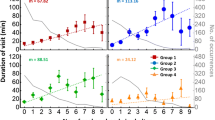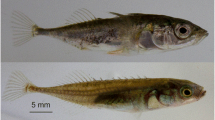Abstract
Snakes live a predominantly solitary and secretive life, and are most often considered to be “non-social”. We here provide quantitative information on the occurrence of basking aggregations, i.e., gatherings of two or more adders having clear physical contact with each other, in the adder (Vipera berus). Overall, approximately 1 out of 10 observed adders was seen in groups that consisted predominantly of two individuals and rarely of 3 up to 7 adders. The incidence of aggregations was higher in the adults than in the younger age classes, and in the adult males than in the adult females. Males and especially females were found much more than expected in single-sex clusters, whereas male–female groups were seen much less frequently. Aggregations of adult males were seen almost exclusively during early spring, and groups with only adult females were mainly noticed during mid-summer. For both sexes, aggregated adders were seen most often during periods when the observation frequency of solitary adders was also highest. Hence, the seasonal variation of adder groupings is not induced by varying levels of the tendency to actively associate with conspecifics. There were no indications that adders actively aggregate in large groups and individual snakes did not exhibit a stronger tendency toward gregariousness than others. Overall, our analyses indicate that the observed aggregations are mainly non-social, but rather reflect the tendency of individual adders to simultaneously select scarce thermally suitable microhabitats.





Similar content being viewed by others
Data availability
The datasets generated during and/or analyzed during the current study are available from the corresponding author on reasonable request.
References
Ameling AD (1978) Dieren dichterbij—de adder. Het Spectrum, Utrecht/Antwerpen
Andrén C (1982) The role of the vomeronasal organs in the reproductive behavior of the Adder Vipera berus. Copeia 1982:148–157
Andrén C (1985) Risk of predation in male and female adders, Vipera berus (Linné). Amphib Reptil 6:203–206. https://doi.org/10.1163/156853885X00100
Andrén C (1986) Courtship, mating and agonistic behaviour in a free-living population of adders, Viper berus (L.). Amphib Reptil 7:353–383
Andrén C, Nilson G (1981) Reproductive success and risk of predation in normal and melanistic colour morphs of the adder, Vipera berus. Biol J Linn Soc 15:235–246
Baron J-P, Ferrière R, Clobert J, Saint Girons H (1996) Stratégie démographique de Vipera ursinii ursinii au Mont-Ventoux. Comptes Rendus l’Acad des Sci 319:57–69
Bauwens D, Claus K (2018) Do newborn adders suffer mass mortality or do they venture into a collective hide-and-seek game? Biol J Linn Soc 124:99–112
Bauwens D, Claus K (2019a) Intermittent reproduction, mortality patterns and lifetime breeding frequency of females in a population of the adder (Vipera berus). PeerJ 7:e6912. https://doi.org/10.7717/peerj.6912
Bauwens D, Claus K (2019b) Seasonal variation of mortality, detectability, and body condition in a population of the adder (Vipera berus). Ecol Evol 9:5821–5834. https://doi.org/10.1002/ece3.5166
Bauwens D, Claus K (2019c) Do female northern vipers (Vipera berus) really stop feeding during pregnancy? Herpetol Bull 147:4–8. https://doi.org/10.33256/hb147.48
Bauwens D, Claus K, Mergeay J (2018) Genotyping validates photo-identification by the head scale pattern in a large population of the European adder (Vipera berus). Ecol Evol 8:2985–2992. https://doi.org/10.1002/ece3.3917
Bonnet X, Lourdais O, Shine R, Naulleau G (2002) Reproduction in a typical capital breeder: costs, currencies, and complications in the aspic viper. Ecology 83:2124–2135. https://doi.org/10.1890/0012-9658(2002)083[2124:RIATCB]2.0.CO;2
Bulteel G (2006) De vegetatie van het Groot Schietveld. Jaarb ANKONA 2004–2005:77–101
Chapple DG (2003) Ecology, life-history, and behavior in the Australian scincid genus Egernia, with comments on the evolution of complex sociality in lizards. Herpetol Monogr. https://doi.org/10.1655/0733-1347(2003)017[0145:elabit]2.0.co;2
Clark RW, Brown WS, Stechert R, Greene HW (2012) Cryptic sociality in rattlesnakes (Crotalus horridus) detected by kinship analysis. Biol Lett 8:523–525. https://doi.org/10.1098/rsbl.2011.1217
Claus K, Bauwens D, Hoeymans B, De Swert T (2016) Vergeten adderhabitats en het behoud van adderpopulaties. Ravon 18:28–32
Doody JS, Burghardt GM, Dinets V (2013) Breaking the social-non-social dichotomy: a role for reptiles in vertebrate social behavior research? Ethology 119:95–103. https://doi.org/10.1111/eth.12047
Gardner MG, Pearson SK, Johnston GR, Schwarz MP (2016) Group living in squamate reptiles: a review of evidence for stable aggregations. Biol Rev 91:925–936. https://doi.org/10.1111/brv.12201
Graves BM, Duvall D (1987) An Experimental study of aggregation and thermoregulation in prairie rattlesnakes (Crotalus viridisviridis). Herpetologica 43:259–264
Graves BM, Duvall D (1995) Aggregation of squamate reptiles associated with gestation, oviposition, and parturition. Herpetol Monogr 9:102–119
Halliwell B, Uller T, Holland BR, While GM (2020) Live bearing promotes the evolution of sociality in reptiles. Nat Commun 8(2030):1–8. https://doi.org/10.1038/s41467-017-02220-w
Herczeg G, Saarikivi J, Gonda A et al (2007) Suboptimal thermoregulation in male adders (Vipera berus) after hibernation imposed by spermiogenesis. Biol J Linn Soc 92:19–27. https://doi.org/10.1111/j.1095-8312.2007.00827.x
Kelleway L (1982) Competition for mates and food items in Vipera berus (L.). Br J Herpetol 5:225–230
Lenders AJW (2003) Overwinteringsplekken en voorjaarszonplekken van de adder in Nationaal Park de Meinweg. Natuurhistorisch Maandbl 92:181–189
Lorioux S, Lisse H, Lourdais O (2013) Dedicated mothers: predation risk and physical burden do not alter thermoregulatory behaviour of pregnant vipers. Anim Behav 86:401–408. https://doi.org/10.1016/j.anbehav.2013.05.031
Lourdais O, Guillon M, DeNardo D, Blouin-Demers G (2013) Cold climate specialization: adaptive covariation between metabolic rate and thermoregulation in pregnant vipers. Physiol Behav 119:149–155. https://doi.org/10.1016/j.physbeh.2013.05.041
Madsen T (1988) Reproductive success, mortality and sexual size dimorphism in the adder, Vipera berus. Holarct Ecol 11:77–80. https://doi.org/10.1111/j.1600-0587.1988.tb00783.x
Madsen T, Shine R, Loman J, Hakansson T (1993) Determinants of mating success in male adders, Vipera berus. Anim Behav 45:491–499
McPhail R (2011) The private life of adders. Merlin Unwin Books, Ludlow
Mouton PLFN (2011) Aggregation behaviour of lizards in the arid western regions of South Africa. African J Herpetol 60:155–170
Nilson G (1980) Male reproductive cycle of the European Adder, Vipera berus, and its relation to annual activity periods. Copeia 1980:729–737
Otte N, Bohle D, Thiesmeier B (2020) Die Kreuzotter, ein Leben in ziemlich festen Bahnen. Laurenti, Bielefeld
Phelps T (2004) Population dynamics and spatial distribution of the adder Vipera berus in southern Dorset, England. Mertensiella 15:241–258
Pleguezuelos JM, Santos X, Brito JC et al (2007) Reproductive ecology of Vipera latastei, in the Iberian Peninsula: Implications for the conservation of a Mediterranean viper. Zoology 110:9–19. https://doi.org/10.1016/j.zool.2006.11.001
Prestt I (1971) An ecological study of the viper Vipera berus in southern Britain. J Zool 164:373–418. https://doi.org/10.1016/0041-0101(72)90132-8
Rabosky ARD, Corl A, Liwanag HEM et al (2012) Direct fitness correlates and thermal consequences of facultative direct fitness correlates and thermal consequences of facultative aggregation in a desert lizard. PLoS ONE 7:e40866. https://doi.org/10.1371/journal.pone.0040866
Schuett GW, Clark RW, Repp RA et al (2016) Social behavior of rattlesnakes: a shifting paradigm. In: Schuett GW, Feldner MJ, Reiserer RS, Smith CF (eds) Rattlesnakes of arizona. Eco Publishing, Rodeo, pp 161–242
Shah B, Shine R, Hudson S, Kearney M (2003) Sociality in lizards: why do thick-tailed geckos (Nephrurus milii) aggregate? Behaviour 140:1039–1052
Shine R, LeMaster MP, Moore IT et al (2001) Bumpus in the snake den: effects of sex, size, and body condition on mortality of red-sided garter snakes. Evolution (N Y) 55:598–604. https://doi.org/10.1111/j.0014-3820.2001.tb00792.x
Sih A, Hanser SF, McHugh KA (2009) Social network theory: new insights and issues for behavioral ecologists. Behav Ecol Sociobiol 63:975–988. https://doi.org/10.1007/s00265-009-0725-6
Skinner M, Miller N (2020) Aggregation and social interaction in garter snakes (Thamnophis sirtalis sirtalis). Behav Ecol Sociobiol. https://doi.org/10.1007/s00265-020-2827-0
Sperry JH, Weatherhead PJ (2009) Sex differences in behavior associated with sex-biased mortality in an oviparous snake species. Oikos 118:627–633. https://doi.org/10.1111/j.1600-0706.2009.17404.x
Stafford P (1987) The Adder. Shire Natural History
Stamps JA (1988) Conspecific attraction and aggregation in territorial species. Am Nat 131:329–347. https://doi.org/10.1086/284793
Thoen C, Bauwens D, Verheyen RF (1986) Chemoreceptive and behavioural responses of the common lizard Lacerta vivipara to snake chemical deposits. Anim Behav 34:1805–1813
Van Moorleghem C, Bauwens D, Claus K et al (2020) Cracking the chemical code: European common lizards (Zootoca vivipara) respond to an hexane soluble predator kairomone. Biochem Syst Ecol. https://doi.org/10.1016/j.bse.2020.104161
Viitanen P (1967) Hibernation and seasonal movements of the viper, Vipera berus berus (L.) in southern Finland. Ann Zool Fennici 4:472–546
Völkl W, Thiesmeier B (2002) Die Kreuzotter: ein Leben in festen Bahnen? Laurenti Verlag, Bielefeld
While GM, Chapple DG, Gardner MG et al (2015) Egernia lizards. Curr Biol 25:R593–R595. https://doi.org/10.1016/j.cub.2015.02.070
Wikelski M (1994) Influences of parasites and thermoregulation on grouping tendencies in marine iguanas. Behav Ecol 10:22–29
Acknowledgements
All field and office work of this citizen science project were carried out on a voluntary basis without funding or any other form of financial support. We thank Tina De Swert, Bart Hoeymans, Wim Mathijssen, and Jurgen Melis for their company and skilled help in the field. Comments by Dr. Raoul Van Damme and Rick Hodges greatly improved the final version of the text. DB and KC are voluntary researchers at the “Functional Morphology” research group, University of Antwerp. The military commander of the “Groot Schietveld” and the “Agentschap voor Natuur en Bos (ANB)” gave permits (ANB/BL-FF/V16-00002; ANB/BL-FF/V19-00024; ANB/BL-FF/V20-00037) to access the area and to study adders. All applicable institutional and national guidelines for the care and use of animals were followed.
Author information
Authors and Affiliations
Corresponding author
Additional information
Publisher's Note
Springer Nature remains neutral with regard to jurisdictional claims in published maps and institutional affiliations.
About this article
Cite this article
Bauwens, D., Claus, K. Basking aggregations in the adder (Vipera berus): attraction to conspecific cues or to scarce suitable microhabitats?. J Ethol 39, 249–257 (2021). https://doi.org/10.1007/s10164-021-00699-x
Received:
Accepted:
Published:
Issue Date:
DOI: https://doi.org/10.1007/s10164-021-00699-x




